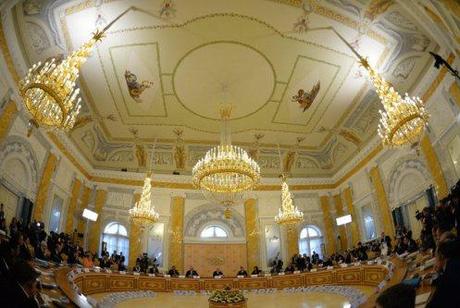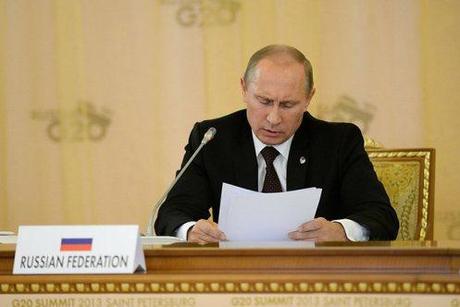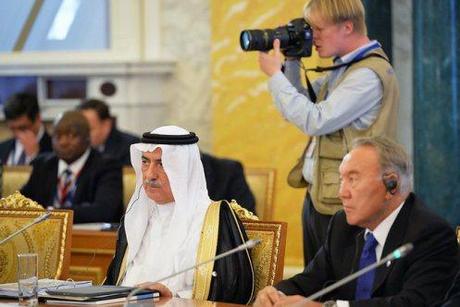Day one of the G20 in Saint Petersburg faded to a close but the air was tense as leaders of the great developed countries of the world met in Russia for a two day summit. The day began with an early meeting of the five BRICS nations and Brazil, Russia, India, China and South Africa announced the creation of a $100 billion dollar foreign reserve exchange fund to handle economic crisis situations among BRICS nations.
Once everyone arrived and had been greeted the G20 sessions began. Syria wasn’t one of the scheduled topics but it was on everyone’s mind so when it came his turn to speak, a clearly subdued and somewhat uncomfortable looking American President Barack Obama brought up the subject, asking leaders to make time to discuss the Syrian situation.

Inside Constantine Palace just outside Saint Petersburg.
The countries included in the G20 are:
- Agrentina
- Australia
- Brazil (BRICS)
- Canada (G8)
- China (BRICS)
- European Union
- France (G8)
- Germany (G8)
- India (BRICS)
- Indonesia
- Italy (G8)
- Japan (G8)
- Mexico
- Russia (G8 & BRICS)
- Saudia Arabia
- South Africa (BRICS)
- South Korea
- Turkey
- United Kingdom (G8)
- USA (G8)
Countries designated (G8) are part of the G8 Group and (BRICS) are part of the alliance between Brazil, Russia, India, China and South Africa.

Russia’s Vladimir Putin is President of the G20 for 2013.
Setting the agenda as part of the rotating G20 presidency, Russian President Vladimir Putin laid out the agenda from the G20′s planning committee which include three central topics:
1- Growth through Quality Jobs and Investment: Mr. Putin told the assembled leaders that the worldwide economy would not fully recover until the world’s leading economies tackled the issues of job growth and jobs creation.
2- Growth through trust and transparency: Here the agenda will focus on harmonization of international financial regulations especially in the areas of offshore tax havens and finding ways to combat tax evasion.
3- Growth through effective international financial regulations: In many cases tax treaties between countries and regulations for investment are very different from country to country and the G20 would like to strengthen financial transparency and find areas in which international investments can be streamlined and standardized in regulatory processes.
For dinner the participants were taken to Peterhof to the Catherine Palace, often called the Summer Palace, which is 25 kilometres southeast of Petersburg. The Catherine Palace is a ornate complex with its renowned Grand Cascade Waterfalls that flow from the palace gardens into the Gulf of Finland.

Hmm, wasn’t it Mr. Obama who just last week characterized Vladimir Putin as a pouting schoolboy?
The subject of Syria was discussed at the dinner meeting and American president Obama seemed to struggle to find support for his defense of air strikes to assist the rebels, most of whom the world community recognizes as being heavily infiltrated by radical Islamic elements despite the naive claims out of Washington.
Now for some trivia; today’s theme is about the journalists covering the G20

Photographer at work near the president of Kazakhstan Nursultan Nazarbaev and the Finance Minister from Saudi Arabia.
1- How many accredited journalists have arrived to cover the 2013 G20?
Answer: 2,880 representing almost every country in the world.
2- How much food have those journalists consumed?
Answer: 26 tons of food just on Thursday, the first day.
3- Where do these journalists stay?
Answer: Not at the Constantine Palace like the dignitaries. Journalists had to find their own hotel accommodations in the city of Saint Petersburg and are not allowed to stay in the immediate area of the Palace.
4- Since buses and mini vans have been prohibited in the areas leading to and around the palace, how to journalists travel back and forth?
Answer: By special hydrofoil boats operated by security forces of the Russian government.
(All photos: Presidential Press, Russian Federation)
